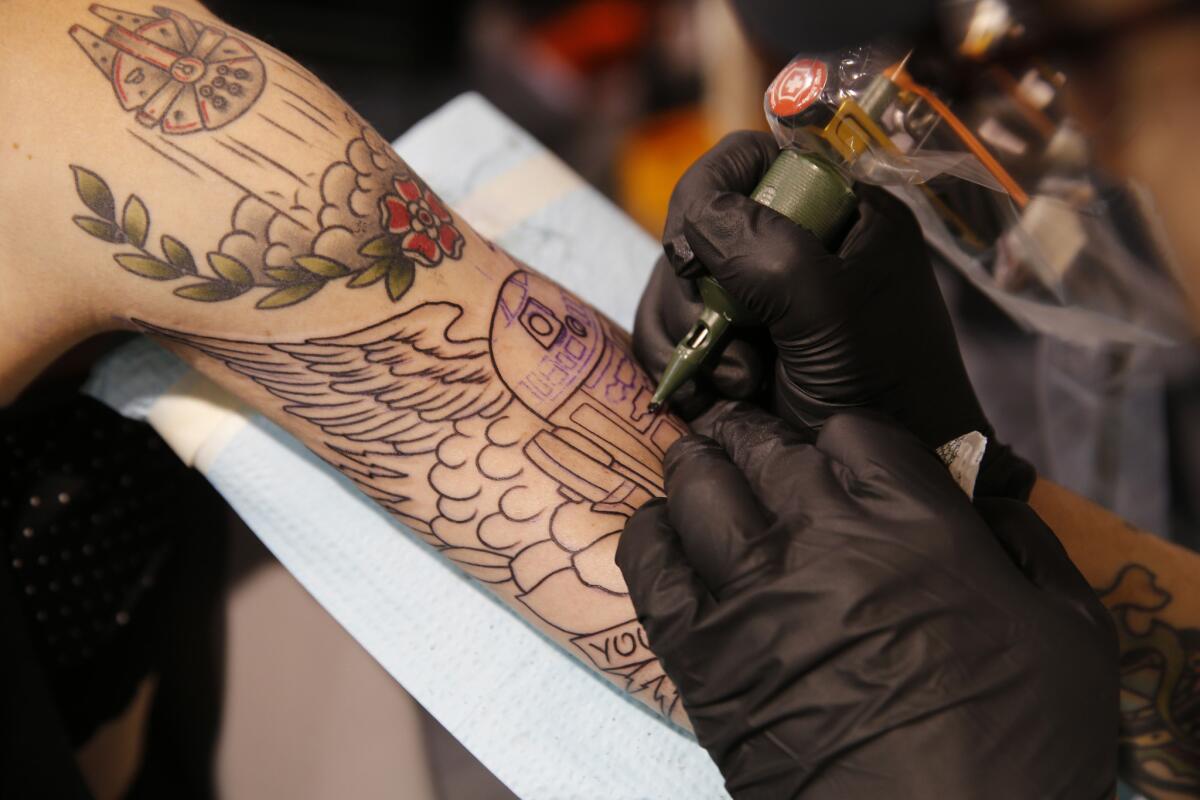The tattoo is becoming less taboo in the workplace

A 2010 study by the Pew Research Center found that nearly 40% of millennials have tattoos, and that nearly half of those who have tattoos sport two to five.
- Share via
More employers, it seems, are getting comfortable with the idea of employee ink.
Recently, the Huffington Post reported that the sandwich chain Jimmy John’s — known for its restrictive dress code that mandates the color of the soles of workers’ shoes and the shade of their khakis — would be loosening its policies about tattoos.
“A little ink is OK, as long as it’s tasteful and not on the face or throat,” a published memo by the sandwich maker says. “No sex, drugs or profanity please. If your mom wouldn’t approve, better cover ‘em up.”
This sounds a lot like the approach several other large employers have recently taken as they make changes to their rules on tattoos. Starbucks and PetSmart made a similar policy shift last year to allow for “appropriate” tattoos.
Even the U.S. Army relaxed its rules this year.
There’s little question that younger workers are fond of body ink, and employers may be trying to respond. A 2010 study by the Pew Research Center found that nearly 40% of millennials have tattoos, and that nearly half of those who have tattoos sport two to five.
It could also be that, as more people with tattoos have risen in the corporate ranks, they’re increasingly supporting policies that are ink-friendly.
There is “definitely” a loosening of restrictions in the restaurant industry, said Brian Elzweig, a law professor at Texas A&M University-Corpus Christi who has studied the legal issues around tattoos in the workplace.
“I think what’s been happening is more and more people who have tattoos are getting into levels of management,” he said, “and whether they’re visible or not, they have a much more lenient attitude.”
Retailers and fast-food companies could also be feeling the crunch of a tighter labor market and generally loosening up their dress codes overall, recognizing that too many restrictions can get in the way of finding the most qualified workers.
In June, Wal-Mart began giving workers a little more choice in the pants they wear to work. Abercrombie & Fitch also made changes to its well-known dress code restrictions this year.
The decision at Jimmy John’s (which the company would not confirm to the Washington Post) may partly have been the result of a petition started on the website Coworker.org that was signed by nearly 9,000 people, including 4,600 who identified as Jimmy John’s employees.
It was inspired by a similar campaign by Starbucks workers, who succeeded last October in encouraging the coffee chain to change its policy to allow visible tattoos. “Letting us express our individuality isn’t really much to ask for,” the campaign to Jimmy John’s declared.
But even if more companies are loosening tattoo restrictions, young people still — probably wisely — have some professional concerns about it.
A recent University of Tampa study found that 86% of students surveyed thought that those who have visible tattoos will have a harder time finding a job. And nearly the same percentage said that if they were to get a tattoo, they would consider getting one where they can hide it.
Jena McGregor writes a daily column analyzing leadership in the news for the Washington Post’s On Leadership section.
Hoy: Léa esta historia en español
More to Read
Inside the business of entertainment
The Wide Shot brings you news, analysis and insights on everything from streaming wars to production — and what it all means for the future.
You may occasionally receive promotional content from the Los Angeles Times.










